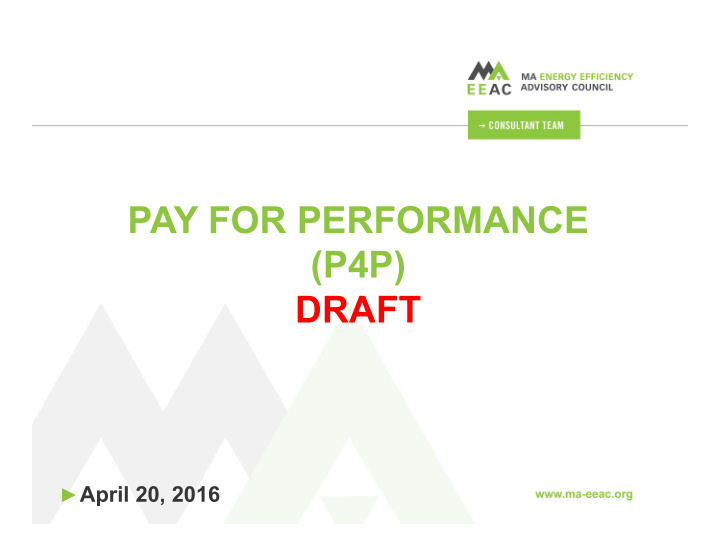



PAY FOR PERFORMANCE (P4P) DRAFT ► April 20, 2016
PAY FOR PERFORMANCE – DEFINITION ► Generally, P4P refers to payment for energy savings that have been confirmed through metering or demonstrated through modeling − There are many flavors of this that we will be reporting on ► There is no standard definition of pay for performance in energy efficiency www.ma-eeac.org Pay for Performance | 2
P4P TERMS ► Components of P4P − Operations & Maintenance (O&M) − Behavior − Capital (describe standard offer) ► Difference from typical programs − Deemed/estimated vs Verified savings ► Design incentive ► Capital incentive ► Commissioning incentive www.ma-eeac.org Pay for Performance | 3
TYPES AND HISTORY OF P4P ► Variations in P4P − Residential and C&I − When payment occurs − What is needed in most cases—metering infrastructure, M&V, data in general—many types can be included − TA and market-based implementers ► ESCo have been doing these kind of projects for a long time − $5B per year in retrofit projects across US − $50B in verified savings since 1990 www.ma-eeac.org Pay for Performance | 4
STANDARD OFFER HYBRID EXAMPLE ► Excel Energy Colorado - Standard Offer Program ► Designed to accommodate the ESCo process ► Description: − A retrofit efficiency program where studies are eligible for 50% cost share − Savings are also eligible for incentives based on kW, kWh or therms when equipment is installed, based on estimated savings. − Monitoring for three years verifies performance. Variation from the estimated savings greater than 10% results in adjustments to the incentive. − This could include customers refunding dollars initially paid out www.ma-eeac.org Pay for Performance | 5
MA REFERENCES ► MassSave P4P − Description: • Promotes commissioning on an ongoing, multi-year basis • Co-funding for technical resources − Process: • After an audit, customer commits to 3 years of monitoring based on projected savings • Vendor implements measures/changes • Monitoring for 1 year to be eligible for incentives • Incentives also available for project management to help move the project forward www.ma-eeac.org Pay for Performance | 6
BONNEVILLE POWER ADMINISTRATION - TRACK AND TUNE ► Description: − Promotes improvements to operations and equipment settings for individual industrial customers − No capital expense required to receive savings or incentive − Co-funding for technical resources and metering equipment ► Process: O&M Savings Savings and Project quantified costs screened annually and determined incentives paid Actions agreed Scope upon and determined measured Tracking system Agreement installed www.ma-eeac.org Pay for Performance | 7
BPA HIGH PERFORMANCE ENERGY MANAGEMENT ► Description: − Promotes improvements to operations and settings for a cohort of industrial customers − Integrates energy efficiency as a core business practice ► Process: Determine Develop Track model vs energy statistical actual energy champion model use Performance Subtract Create energy indicators capital project team (kWh/ widget) savings Assess current Communicate O&M Savings energy to and educate quantified and management employees incentives paid practices Identify ways Set Goals to improve www.ma-eeac.org Pay for Performance | 8 energy use
PAY FOR PERFORMANCE IN NEW CONSTRUCTION—NJ CLEAN ENERGY ► Description: − Offers incentives to C&I and institutional customers with buildings > than 50k SF for comprehensive, whole-building approach to saving energy ► Process: • Submittal of proposed energy reduction plan Incentive #1 • Incentives based on $0.10 per square foot up to $50,000 • Submittal of as ‐ built energy reduction plan Incentive #2 • Incentives based on $1.00 per square foot • Submittal of complete commissioning report Incentive #3 – • If threshold of 15% better than code achieved, incentives P4P based on $0.35 to $0.65 per square foot www.ma-eeac.org Pay for Performance | 9
RESIDENTIAL PAY FOR PERFORMANCE—NY MULTIFAMILY PERFORMANCE PROGRAM ► Description: − Performance based whole-building, fuel blind program targeting 20% source energy savings per building − Market based delivery model: “Program Partners” set prices for services with incentives available at key stages − “Pay for performance” optional kicker incentive ► Results − 17% average savings per building − No statistical correlation between P4P applicants and achievement of savings goals Realization Rates NTG Building Type Electric Fossil Fuel Electric Fossil Fuel All Retrofit 0.78 0.57 0.55 0.58 Market Rate Retrofit 0.88 0.78 www.ma-eeac.org Pay for Performance | 10
RESIDENTIAL EXAMPLE— PENDING PROPOSAL FROM CA ► Goals: − Develop scalable model for residential retrofits leveraging rapidly emerging market actors and products − Minimize administrative and implementation costs ► Services provided by aggregators who bid for funding through power savings agreements, e.g.: − PACE loan providers − Smart thermostat vendors − Vertically integrated contractors − Program implementers ► PG&E would pay for aggregators’ portfolio kWh and therm savings measured through AMI − Payments made annually one and two years after initial intervention based on aggregators’ total portfolio www.ma-eeac.org Pay for Performance | 11
RESIDENTIAL EXAMPLE— PENDING PROPOSAL FROM CA ► Advantages to model according to PG&E: − Allows participation by more market actors − Provides flexibility for contractors to choose services and products that customers want and that save energy − Combines measure installation with operational and behavioral interventions − Limits risk to ratepayer funds by paying incentives only for energy savings that materialize at the meter ► Initial enrollment period: 2016-2019 − $6 million total budget, $5 million incentive budget − 2,100 customers/year − $1,500/home − 3-5 aggregators, 50 active contractors www.ma-eeac.org Pay for Performance
CONSIDERATIONS Measurement Customer Impact EM&V • Performance not • Shifts the risk of failed • Requires longer ‐ always a product solely projects more onto the term/multi ‐ year M&V of better practice building owners involvement • Numerous factors can • Some owners may not • Naturally occurring EE skew performance have the time or needs to be part of the • Combination of capital money to invest more conversation • Attribution is harder to projects and comprehensive O&M/behavior might projects determine need to be separated • Does not work as well when dual baselines exist www.ma-eeac.org Pay for Performance | 13
QUESTIONS? Thank you ► April 20, 2016
Recommend
More recommend